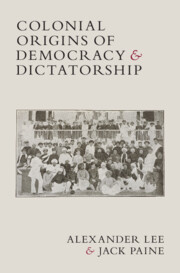Book contents
- Frontmatter
- Contents
- Figures
- Tables
- Acknowledgments
- 1 Introduction
- 2 A Theory of Colonial Electoral Institutions
- 3 Representation in Settler Colonies through 1850
- 4 Imperial Expansion and Restrictive Elections: 1850–1945
- 5 Mass Franchise Expansion after 1945
- 6 Postcolonial Persistence
- 7 Conclusion
- Appendix: Data and Regression Analysis
- References
- Index
3 - Representation in Settler Colonies through 1850
Published online by Cambridge University Press: 08 May 2024
- Frontmatter
- Contents
- Figures
- Tables
- Acknowledgments
- 1 Introduction
- 2 A Theory of Colonial Electoral Institutions
- 3 Representation in Settler Colonies through 1850
- 4 Imperial Expansion and Restrictive Elections: 1850–1945
- 5 Mass Franchise Expansion after 1945
- 6 Postcolonial Persistence
- 7 Conclusion
- Appendix: Data and Regression Analysis
- References
- Index
Summary
Before the nineteenth century, most European colonies were located in the New World. British colonies experienced more electoral competition because of parliamentary institutions at home. British-settled colonies in North America, the West Indies, and Oceania routinely gained fully elected assemblies shortly after settlement. However, the early British empire was far from democratic: voting rights were confined to white property-owning men, London occasionally pushed back on settlers’ policymaking autonomy (prompting the American Revolution), and colonies with Catholic or convict populations experienced long delays before gaining electoral representation. Prior to the French Revolution, colonists in the French, Spanish, and Portuguese empires lacked electoral representation beyond the municipal level. Afterward, political transformations in authoritarian metropoles triggered reforms to colonial institutions. France fluctuated between democratic and authoritarian institutions after the French Revolution, and colonial institutions closely tracked metropolitan patterns. Spain and Portugal engaged in abortive electoral reforms in their colonies, which preceded the dissolution of their American empires.
Keywords
- Type
- Chapter
- Information
- Colonial Origins of Democracy and Dictatorship , pp. 50 - 89Publisher: Cambridge University PressPrint publication year: 2024



